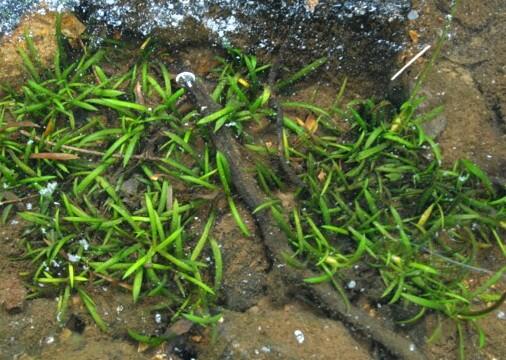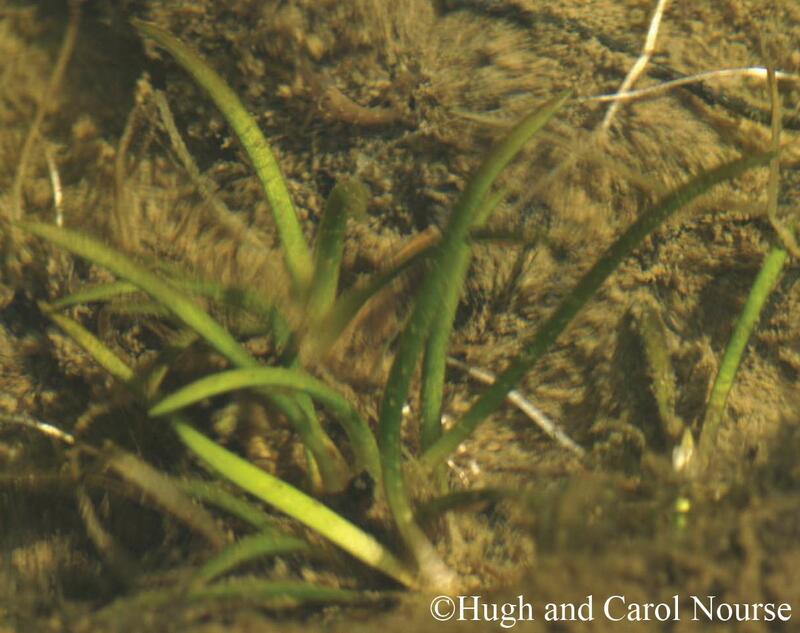





Loading profile. Please wait . . .
Sagittaria secundifolia Kral
Kral's Water-plantain






Federal Protection: Listed Threatened
State Protection: Threatened
Global Rank: G1
State Rank: S1
Element Locations Tracked in Biotics: Yes
SWAP 2015 Species of Greatest Conservation Need (SGCN): Yes
SWAP 2025 Species of Greatest Conservation Need (SGCN): Yes
2025 SGCN Priority Tier: Highest Conservation Concern
Element Occurrences (EOs) in Georgia: 1
Habitat Summary for element in Georgia: Crevices in sandstone in fast flowing streams
Aquatic perennial herb with slender, green, underwater stems up to 4 inches (10 cm) long, lodged in cracks of rocks, with leaf bases overlapping in a row along one side of the underwater stem. Leaves of plants in swift-flowing or shallow water are 0.8 - 4 inches (2 - 10 cm) long and less than 0.2 inch (2 - 5 mm) wide, erect, flat, and curved. Leaves of plants in deep or quiet water are 2 - 12 inches (5 - 30 cm) long, very narrow, round in cross-section except for a flat, angular tip. The flower stalk is 4 - 20 inches (10 - 50 cm) tall, leafless, with 2 - 5 whorls of flowering branches; the stalk is usually held erect above the water, at least at the tip. Female flowers are on lower branches, and have no petals. Male flowers are on upper branches, and have 3 white petals. Fruits are held in tight, round clusters on erect or spreading stalks; the fruit is flat with a spur-like beak, a scalloped or toothed wing, and a ridged and bumpy surface.
Grass-leaved Water-plantain (Sagittaria graminea) leaves are larger and broader, and it has up to 12 whorls of flowering branches in its inflorescences; its fruits are winged but the wing is not scalloped or toothed.
Ovate-leaved Arrowhead (Sagittaria platyphylla, Special Concern) is a large plant with broad, oval leaves up to 6.5 inches (16.4 cm) long and leaf stalks to 28 inches (70.5 cm) long; it occurs in ponds, ditches, swamps, and marshes in Chatham and Liberty counties.
Narrow, unpolluted streams over sandstone; cracks in sandstone riverbeds, exposed rocky shoals, and among boulders in quiet stream pools. Often with other aquatic species such as Pondweed (Potamogeton spp., Water Milfoil (Myriophyllum spp.), and Riverweed (Podostemum ceratophyllum).
Although capable of sexual reproduction, Kral’s Water-plantain spreads primarily by growth of its underwater stems (rhizomes). Female and male flowers occur separately on the same plant, with female flowers held on lower branches, male on upper. Plants flower only in full sun and where low water levels permit growth of abovewater leaves. Bees are likely pollinators but little is known about Kral’s Water-plantain reproduction.
Plants flower infrequently, but may be identified by leaves and underwater stem throughout the growing season in wet years; plants may become dormant during droughts. Flowers May–August, fruits July–September.
Little River drainage (northwest Georgia, northeast Alabama), Town Creek (northeast Alabama), Sipsey Fork of the Black Warrior River (northwest Alabama), and Hatchet Creek (central Alabama).
Pollution and siltation of streams and rivers by agricultural runoff, mining, and development. Damming of streams. Off-road vehicle use in streams.
| Threat 1 | Threat 2 | Threat 3 | |
|---|---|---|---|
| General Threat | Pollution | Natural system modifications | Human intrusions & disturbance |
| Specific Threat | None | None | None |
One population, in private ownership, is known.
Protect water quality. Prevent siltation of riverbeds from agriculture, mining, and development activities. Avoid damming or otherwise altering stream flow. Prevent off-road-vehicle access.
Chafin, L.G. 2007. Field guide to the rare plants of Georgia. State Botanical Garden of Georgia and University of Georgia Press, Athens.
GADNR. 2020. Element occurrence records for Sagittaria secundifolia. Georgia Department of Natural Resources, Wildlife Resources Division, Social Circle, Georgia.
Haynes, R.R. and C.B. Hellquist. 2000. Sagittaria secundifolia species account. Flora of North America, Vol. 22. Oxford University Press. http://beta.floranorthamerica.org/Sagittaria_secundifolia
Keener, B.R. 2005. Molecular systematics and revision of the aquatic Monocot genus Sagittaria (Alismataceae). Dissertation, University of Alabama, Tuscaloosa. https://tinyurl.com/ybue22fm
Kral, R. 1982. A new phylloidial-leaved Sagittaria (Alismataceae) from Alabama. Brittonia 34:12-17.
Kral, R. 1983. A report on some rare, threatened, or endangered forest-related vascular plants of the South. Technical Publication R8-TP2. United States Forest Service, Atlanta.
NatureServe. 2020. Species account for Sagittaria secundifolia. NatureServe Explorer. NatureServe, Arlington, Virginia. https://explorer.natureserve.org/Taxon/ELEMENT_GLOBAL.2.146562/Sagittaria_secundifolia
Patrick, T.S., J.R. Allison, and G.A. Krakow. 1995. Protected plants of Georgia. Georgia Department of Natural Resources, Natural Heritage Program, Social Circle.
Spaulding, D.D., T.W. Barger, H.E. Horne, and B.J. Finzel. 2019. Sagittaria secundifolia species account. Flora of Northern Alabama, part 4, Basal Monocots. Phytoneuron 47:1-132. https://tinyurl.com/yd622vhp
USFWS. 2019. Kral’s Water-plantain (Sagittaria secundifolia) species profile and related documents. U.S. Fish and Wildlife Service, Jackson, Mississippi. https://ecos.fws.gov/ecp0/profile/speciesProfile?sId=8235
Weakley, A.S. 2015. Flora of the southern and mid-Atlantic States. University of North Carolina Herbarium, University of North Carolina, Chapel Hill. http://www.herbarium.unc.edu/flora.htm
Whetstone, R.D., C.L. Lawler, L.H. Hopkins, A.L. Martin, and C.C. Dickson. 1987. Kral’s water-plantain, Sagittaria secundifolia Kral (Alismataceae), new to Georgia. Castanea 52: 313. https://www.jstor.org/stable/4033412?seq=1#metadata_info_tab_contents
Linda G. Chafin
L.Chafin, Aug. 2008: original account
D.Weiler, Feb. 2010: added pictures
Z. Abouhamdan, April 2016: updated link
L. Chafin, May 2020: updated original account.




